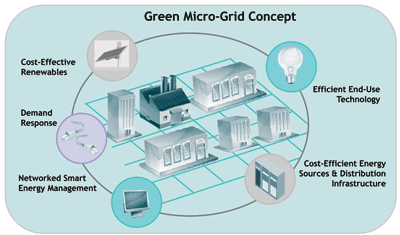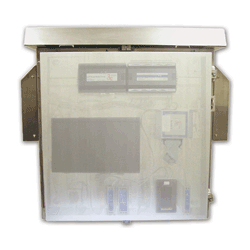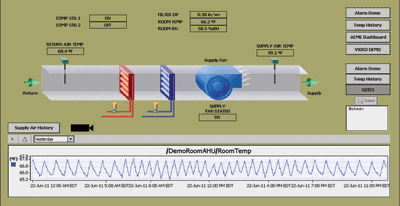The fragile electric grid needs R&D investment in smart-grid technologies for a smarter, more secure electric system
BY BENGA ERINLE, President
3eTI, an Ultra Electronics Company
www.ultra-3eti.com
The U.S. is the world’s largest consumer of energy. As a nation, our demand on the national electrical grid is creating an exorbitant amount of unnecessary costs and security risks. This grid suffers weaknesses ranging from overtaxed capabilities and outdated equipment to susceptibility from cyber threats.
As a result, it has become a source of vulnerability for our critical assets, including the DoD facilities, which rely on it to support our armed forces at home and abroad. Opportunity exists to build more efficient and resilient energy systems that consume less energy and are protected from disasters, accidents and attacks so we can focus on meeting other national security initiatives.
In an effort to increase our energy efficiency and reduce energy related risks to national security, federal agencies have set mandates that will drive energy consumption lower, reduce greenhouse gas output, and increase our use of alternative energy sources. A key feature of this initiative is the modernization of the nation’s electric grid, by investing in research, development, and demonstration of smart-grid technologies that will spur the transition to a smarter, more efficient, secure and reliable electric system.
For its part, the U.S. Navy is focusing on a smart-energy strategy that includes building Green MicroGrids (see Fig. 1 ). These specialized electric grids leverage the best of smart-grid technology and renewable energy sources, and coordinate them to use fuel efficiently, creating a smart infrastructure. Ideally, Green MicroGrids will deliver reliable, economic, and sustainable services, which will allow the Navy to use renewable energy sources, monitor and control its consumption, and ultimately achieve zero net-energy use, all within a secure infrastructure framework.

Fig. 1: The Navy’s Green MicroGrid green micro-grid concept.
The smart-energy strategy
This agenda may seem ambitious but the Navy has created a detailed plan based on three strategic tenets to achieve its smart-energy goals: renewable and sustainable energy sources; increased energy efficiency, including measurable ROI; and cultural and behavioral change within its population relative to energy usage.
Due to its critical role in our nation’s security, the Navy’s compliance with federal mandates requires specific measures to ensure its communications infrastructure and security capabilities are preserved throughout any smart-energy adoption and implementation efforts. Additionally, as any widespread infrastructure modification requires significant investment, cost is an equally important factor in determining the appropriate solution to support the Navy’s objectives.
After extensive evaluation of potential solutions, the Navy accredited the use of 3eTI’s EnergyGuard solution (see Fig. 2 ) to provide a key component of the architecture that underpins a Navy Green Grid in the Washington, DC, area. 3eTI, an Ultra Electronics company, is a provider of secure wireless networks for the defense and industrial markets, enabling the security of critical systems and infrastructure as well as efficient and effective management of industrial and military facilities.

Fig. 2: EnergyGuard provides security of critical systems and infrastructures
EnergyGuard provides an FIPS 140-2-validated, Common Criteria and Wi-Fi Alliance certified solution, which enables a single secure platform allowing Navy managers to monitor, control and optimize energy across all of its facilities from one central location using energy dashboard applications. In brief, EnergyGuard allows the Navy to keep smart-grid information and control in the right hands, thereby driving the Navy’s Green Grid objectives while maintaining DoD levels of security.
Controlling energy and cost
Although EnergyGuard is recently Navy accredited, it has been deployed in over 100 buildings where it is successfully providing analysis, modeling, and prediction capabilities for building systems from metering applications to monitoring mechanical systems. Using the same technology as military environments requiring the highest levels of security, accuracy and durability, EnergyGuard allows system managers to find energy efficiencies (see Fig. 3 ) within their building automation system without having to replace legacy components.
For example, the Navy measures network-wide energy usage by way of integrated smart meters deployed across all of its bases, metering electricity, steam, water and gas. Using a 3eTI-based scalable wireless mesh network, the smart meters are integrated into an advanced metering infrastructure (AMI) for reliable device management. The insights gleaned from this monitoring capability are providing high-level awareness of consumption to support overarching analysis of how to increase these gains universally.

Fig. 3: Energy Guard platform that monitors, controls, and optimizes energy across all facilities
The Navy’s resources are vast, and therefore, the opportunity exists to realize significant cost savings even from small efficiencies generated system-wide. Likewise, as any agency-wide initiative, the sheer extent of these resources presents challenges in their diversity. For example, many Navy buildings were built at different times so they lack common network controls and contain unique security vulnerabilities resulting from such a diverse infrastructure.
The Navy required a cost-effective and accredited network capability to monitor legacy supervisory control and data acquisition (SCADA) and direct digital controls (DDC) associated with their facilities’ critical infrastructure equipment and systems. The 3eTI-based solution was designed to integrate disparate multivendor systems into a local, regional and national system with centralized, real-time monitoring and analysis. As an added measure, the solution also helps protect their precious resources by assuring resilient energy systems are shielded from threats.
Status to date
The Navy program has already generated positive results, with the Navy enjoying improved base operations, operational decision-making, energy commodity management, and real-time support and maintenance.
The Navy is on its way to meeting its mandates, including increased alternative energy ashore and net-zero installations, and decreased non-tactical vehicle fossil fuel consumption and shore energy consumption. Additionally, the Navy is on track to improve energy security by identifying shore energy supply infrastructure vulnerabilities. EnergyGuard is one of 27 new DoD emerging energy technologies on military installations to be demonstrated through its installation Energy Test Bed initiative in 2012. These demonstrations generate the cost and performance data needed to validate promising technologies, allowing them to be fielded and commercialized more rapidly. These technologies will enable DoD’s installations to operate using less energy, and they will improve energy security by allowing installations to maintain critical activities even if the commercial electric grid is disrupted.
These measurable, positive results are significant and show great promise in helping the Navy and other federal agencies achieve their Green objectives while maintaining DoD levels of security. However, the benefits of the EnergyGuard solution go far beyond the Navy’s Green Grid initiative. The real value here is that by integrating these systems within a base, then region, and over a national sensor network, the Navy is in fact establishing an element of its Green Grid that enables it to act in the event of another energy crisis. For instance, in an energy crisis, the Navy would be able to centrally secure power to non-essential systems and buildings, thereby ensuring that mission critical systems keep operating.
3eTI continues to assist the Navy in tracking and reporting EnergyGuard’s contributions to achieving its Green Grid goals efficiently, securely and intelligently. As demand for cost-effective energy and resource management continues to grow, 3eTI solutions can help other federal agencies and industrial institutions to reduce energy intensity, increase alternative energy sources, reduce operational costs, and find interoperable solutions that integrate with legacy equipment without having to invest huge funds in new equipment. This allows them to monitor and control critical industrial systems that immediately save energy and put them on the path to energy independence. ■
Advertisement
Learn more about Ultra Electronics, 3e Technologies International





